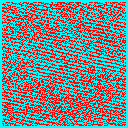
At early times the universe was both denser and smoother than it is today. Superposed upon this smooth background were small fluctuations, both in the temperature of the cosmic microwave background and the density of matter. The cosmic microwave background anisotropies that we see are a snapshot of the universe at an early time when the fluctuations were extremely small: 1 part in 100,000. What we see around us today in redshift surveys are highly concentrated structures (galaxies, clusters of galaxies, ...). How do we link the early time picture provided by the CMB to what we see today?
Under the action of gravity the small fluctuations in the matter density grew. Regions which were slightly overdense (compared to their surroundings) had a slightly larger than average gravitational potential and so accreted matter from the surroundings, in the process becoming even more overdense. Similarly the slightly underdense regions grew more underdense. This constant amplification of the intially very small fluctuations gave rise to all of the structures we see in the universe today.
The movie below shows the action of gravity enhancing small inhomogeneities (a higher resolution movie showing the evolution of the gas density in a cosmological constant model is also available. The same model with 1keV of energy injected at z=7 is here.) The box is a thin slice through a simulation of size 100Mpc of a CDM universe (the expansion of the universe has been ``scaled out'' for ease of viewing) from early times until the present. Notice that under the mutual attraction of gravity the initially smooth distribution of particles (red) develops clumps and knots.
